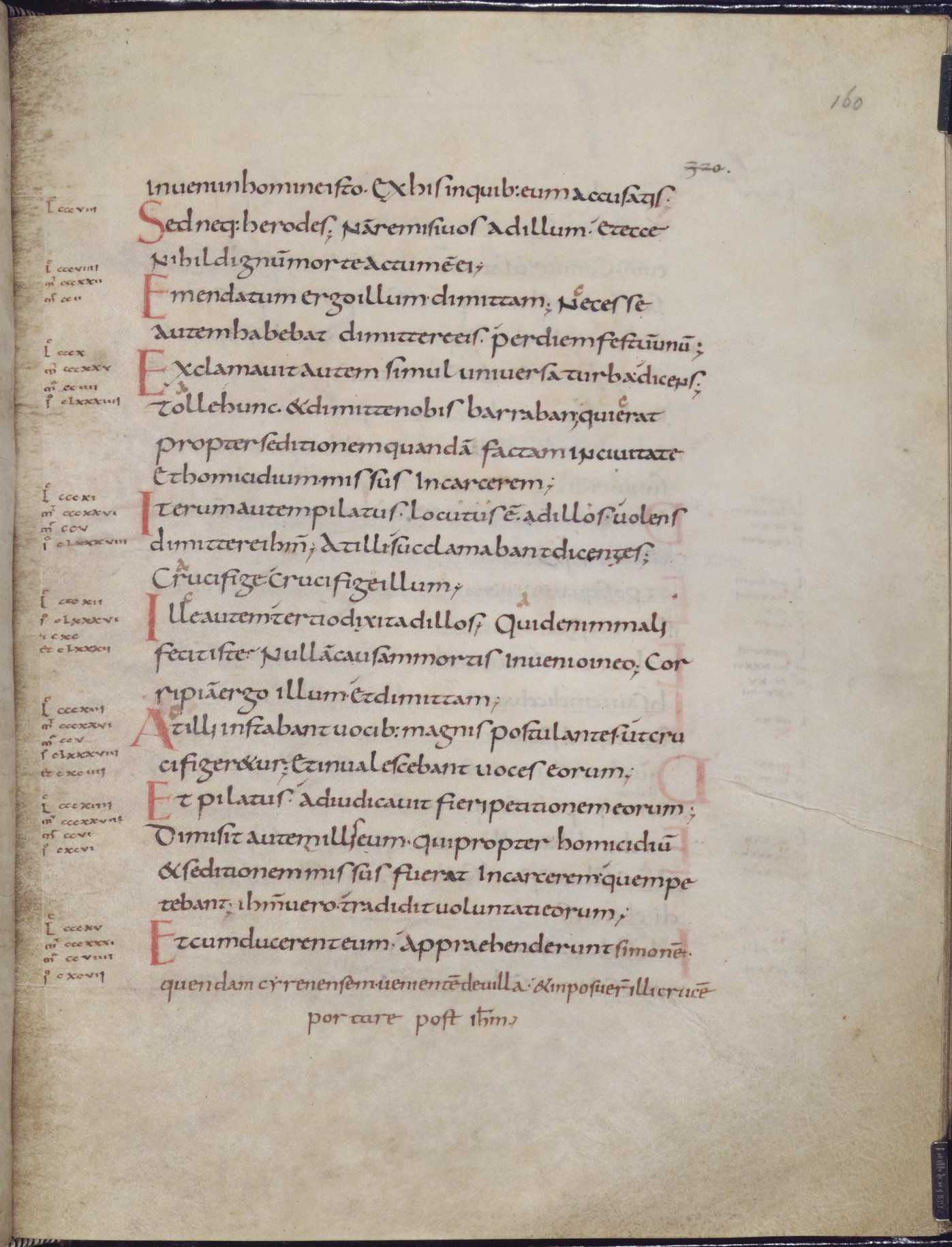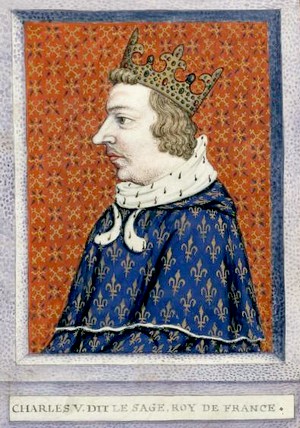|
Sainte-Chapelle Gospels
The Sainte-Chapelle Gospels or the Sainte-Chapelle Gospel Book is an Ottonian illuminated manuscript now housed in the Bibliothèque nationale de France in Paris as Latin 8851. It is made up of 156 parchment folios, in a 38.5 cm by 28 cm format, making it one of the largest manuscripts of its era. It includes miniatures such as the canon tables, Christ in majesty and the Four Evangelists. It is the work of the Master of the Registrum Gregorii, the most famous illuminator of the Ottonian Renaissance. Dating and provenance It does not contain a miniature showing the man or woman who commissioned it (probably someone of high rank) and it does not have a title page, making its dating uncertain. On its title page for St Matthew's Gospel (folio 16, recto) are four medallions showing inscribed portraits of one of the sovereigns of the era, one in each side of the border: *Top: OTTO IMPERATOR AVG(ustus) ROMANOR(um) (Otto, Emperor Augustus of the Romans, ie Otto I or Otto II) *Base: OTTO ... [...More Info...] [...Related Items...] OR: [Wikipedia] [Google] [Baidu] |
Master Of The Registrum Gregorii
The Master of the Registrum Gregorii, also known as the Registrum Master or the Gregory Master, was an anonymous 10th-century scribe and illuminator, active in Trier during the episcopate of Egbert of Trier. His work is generally figural and characterized by large, statuesque figures enveloped in highly stylized drapery that suggest a volumetric body beneath them. Shading is accomplished by lightening with white and darkening with deeper tones of the same color. The heads of the figures tend to be proportionally small, however, the faces are rendered especially well. The attention to individual details suggests portraiture. Backgrounds are sparse or a flat gradient of usually a single color with the lighter shade above and the darker below. Overall, the Master of the Registrum Gregorii's style is iconic and monumental and represents the pinnacle of Ottonian manuscript illumination.Brodsky, Pavel and Jan Parez. Katalog Iluminovanéch rukopisu Strahovské Knihovny. Prague: Bibliotec ... [...More Info...] [...Related Items...] OR: [Wikipedia] [Google] [Baidu] |
Henry II Of Bavaria
Henry II (951 – 28 August 995), called the Wrangler or the Quarrelsome (), a member of the German royal Ottonian dynasty, was Duke of Bavaria from 955 to 976 and again from 985 to 995, as well as Duke of Carinthia from 989 to 995. Life Henry was the son of Duke Henry I of Bavaria, (who in turn was the younger brother of King Otto I of Germany (Emperor from 962)), and ... [...More Info...] [...Related Items...] OR: [Wikipedia] [Google] [Baidu] |
Trier
Trier ( , ; ), formerly and traditionally known in English as Trèves ( , ) and Triers (see also Names of Trier in different languages, names in other languages), is a city on the banks of the Moselle (river), Moselle in Germany. It lies in a valley between low vine-covered hills of red sandstone in the west of the state of Rhineland-Palatinate, near the border with Luxembourg and within the important Mosel (wine region), Moselle wine region. Founded by the Ancient Romans, Romans in the late 1st century BC as ''Augusta Treverorum'' ("The City of Augustus among the Treveri"), Trier is considered Germany's oldest city. It is also the oldest cathedral, seat of a bishop north of the Alps. Trier was one of the four capitals of the Roman Empire during the Tetrarchy period in the late 3rd and early 4th centuries. In the Middle Ages, the archbishop-elector of Trier was an important prince of the Church who controlled land from the French border to the Rhine. The archbishop-elector of Tr ... [...More Info...] [...Related Items...] OR: [Wikipedia] [Google] [Baidu] |
Tours
Tours ( ; ) is the largest city in the region of Centre-Val de Loire, France. It is the Prefectures in France, prefecture of the Departments of France, department of Indre-et-Loire. The Communes of France, commune of Tours had 136,463 inhabitants as of 2018 while the population of the whole functional area (France), metropolitan area was 516,973. Tours sits on the lower reaches of the Loire, between Orléans and the Atlantic Ocean, Atlantic coast. Formerly named Caesarodunum by its founder, Roman Augustus, Emperor Augustus, it possesses one of the largest amphitheaters of the Roman Empire, the Tours Amphitheatre. Known for the Battle of Tours in 732 AD, it is a National Sanctuary with connections to the Merovingian dynasty, Merovingians and the Carolingian dynasty, Carolingians, with the Capetian dynasty, Capetians making the kingdom's currency the Livre tournois. Martin of Tours, Saint Martin and Gregory of Tours were from Tours. Tours was once part of Touraine, a former provi ... [...More Info...] [...Related Items...] OR: [Wikipedia] [Google] [Baidu] |
Carolingian Renaissance
The Carolingian Renaissance was the first of three medieval renaissances, a period of cultural activity in the Carolingian Empire. Charlemagne's reign led to an intellectual revival beginning in the 8th century and continuing throughout the 9th century, taking inspiration from ancient Roman and Greek culture and the Christian Roman Empire of the fourth century. During this period, there was an increase of literature, writing, visual arts, architecture, music, jurisprudence, liturgical reforms, and scriptural studies. Carolingian schools were effective centers of education, and they served generations of scholars by producing editions and copies of the classics, both Christian and pagan. The movement occurred mostly during the reigns of Carolingian rulers Charlemagne and Louis the Pious. It was supported by the scholars of the Carolingian court, notably Alcuin of York. Charlemagne's '' Admonitio generalis'' (789) and '' Epistola de litteris colendis'' served as manifesto ... [...More Info...] [...Related Items...] OR: [Wikipedia] [Google] [Baidu] |
Touraine
Touraine (; ) is one of the traditional provinces of France. Its capital was Tours. During the political reorganization of French territory in 1790, Touraine was divided between the departments of Indre-et-Loire, :Loir-et-Cher, Indre and Vienne. Geography Traversed by the river Loire and its tributaries the Cher, the Indre and the Vienne, Touraine makes up a part of the western Paris Basin. It is well known for its viticulture. The TGV high-speed train system, which connects Tours with Paris (200 kilometers away) in just over an hour, has made Touraine a place of residence for people who work in the French capital but seek a different quality of life. History Touraine takes its name from a Celtic tribe called the Turones, who inhabited the region about two thousand years ago. In 1044, the control of Touraine was given to the Angevins, who (as the House of Plantagenet) became kings of England in 1154, the castle of Chinon being their greatest stronghold. In 1205, Phil ... [...More Info...] [...Related Items...] OR: [Wikipedia] [Google] [Baidu] |
Scriptorium
A scriptorium () was a writing room in medieval European monasteries for the copying and illuminating of manuscripts by scribes. The term has perhaps been over-used—only some monasteries had special rooms set aside for scribes. Often they worked in the monastery library or in their own rooms. Most medieval images of scribing show single figures in well-appointed studies, although these are generally author portraits of well-known authors or translators. Increasingly, lay scribes and illuminators from outside the monastery also assisted the clerical scribes. By the later Middle Ages secular manuscript workshops were common, and many monasteries bought more books than they produced themselves. The functional outset When monastic institutions arose in the early sixth century (the first European monastic writing dates from 517), they defined European literary culture and selectively preserved the literary history of the West. Monks copied Jerome's Latin Vulgate Bible and ... [...More Info...] [...Related Items...] OR: [Wikipedia] [Google] [Baidu] |
Sainte-Chapelle
The Sainte-Chapelle (; ) is a royal chapel in the Gothic style, within the medieval Palais de la Cité, the residence of the Kings of France until the 14th century, on the Île de la Cité in the River Seine in Paris, France. Construction began sometime after 1238 and the chapel was consecrated on 26 April 1248. The Sainte-Chapelle is considered among the highest achievements of the Rayonnant period of Gothic architecture. It was commissioned by King Louis IX of France to house his collection of Passion relics, including Christ's claimed Crown of Thorns – one of the most important relics in medieval Christendom. This was later held in the nearby Notre-Dame Cathedral until the 2019 fire, which it survived. Along with the Conciergerie, Sainte-Chapelle is one of the earliest surviving buildings of the Capetian royal palace on the Île de la Cité. Although damaged during the French Revolution and restored in the 19th century, it has one of the most extensive 13th- ... [...More Info...] [...Related Items...] OR: [Wikipedia] [Google] [Baidu] |
Charles V Of France
Charles V (21 January 1338 – 16 September 1380), called the Wise (; ), was King of France from 1364 to his death in 1380. His reign marked an early high point for France during the Hundred Years' War as his armies recovered much of the territory held by the English and successfully reversed the military losses of his predecessors. Charles became regent of France when his father John II of France, John II was captured by the English at the Battle of Poitiers in 1356. To pay for the defense of the kingdom, Charles raised taxes. As a result, he faced hostility from the French nobility, nobility, led by Charles II of Navarre, Charles the Bad, List of Navarrese monarchs, King of Navarre; the opposition of the French bourgeoisie, which was channeled through the Estates General (France), Estates-General led by Étienne Marcel; and with a peasant revolt known as the Jacquerie. Charles overcame all of these rebellions, but in order to liberate his father, he had to conclude the Treaty ... [...More Info...] [...Related Items...] OR: [Wikipedia] [Google] [Baidu] |
Echternach Abbey
The Abbey of Echternach is a Benedictine monastery in the town of Echternach, in eastern Luxembourg. The abbey was founded in the 7th century by St Willibrord, the patron saint of Luxembourg. For three hundred years, it benefited from the patronage of a succession of rulers, and was the most powerful institution in Luxembourg. The abbey is currently a popular tourist attraction mostly on account of an annual dancing procession that is held every Whit Tuesday. Tens of thousands of tourists, day-trippers, pilgrims, and clergy visit Echternach to witness or participate in the traditional ceremony. History Willibrord Located by the River Sauer, Echternach had originally been the site of a 1st-century Roman villa. By the 6th century, the estate had been passed to the see of Trier, who constructed a small monastery on the estate. In 698, Irmina of Oeren granted the Northumbrian missionary Willibrord, Bishop of Utrecht, land at Echternach to build a larger monastery, appo ... [...More Info...] [...Related Items...] OR: [Wikipedia] [Google] [Baidu] |





